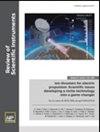A spectroscopic analysis code for spatially resolved x-ray absorption data from the COAX platform
IF 1.3
4区 工程技术
Q3 INSTRUMENTS & INSTRUMENTATION
引用次数: 0
Abstract
Sophisticated tools such as computer vision techniques in combination with 1D lineout type analyses have been used in automating the analysis of spectral data for high energy density (HED) plasmas. Standardized automation can solve the problems posed by the complexity of HED spectra and the quantity of data. We present a spectroscopic code written for automated and streamlined analysis of spatially resolved x-ray absorption data from the COAX platform on Omega-60. COAX uses radiographs and spectroscopic diagnostics to provide shock position and density information. We also obtain the more novel spectral-derived spatial profile of the supersonic radiation flow into a low-density foam. Considerable effort has been spent modernizing our previous spectroscopic analysis method, including the development of new tools characterized by a faster runtime and minimal user input to reduce bias and a testing suite for verifying the accuracy of the various functions within the code. The new code analyzes our spectroscopic images in 1–2 min, with added uncertainty and confidence.用于 COAX 平台空间分辨 X 射线吸收数据的光谱分析代码
计算机视觉技术与一维线型分析相结合等先进工具已被用于高能量密度(HED)等离子体光谱数据的自动化分析。标准化自动化可以解决 HED 光谱的复杂性和数据量所带来的问题。我们介绍了为自动和简化分析来自 Omega-60 上 COAX 平台的空间分辨 X 射线吸收数据而编写的光谱代码。COAX 利用射线照相和光谱诊断来提供冲击位置和密度信息。我们还获得了更新颖的超音速辐射流进入低密度泡沫的光谱空间剖面图。我们花费了大量精力对以前的光谱分析方法进行现代化改造,包括开发新工具,其特点是运行时间更快,用户输入最少,以减少偏差,并开发了一套测试工具,用于验证代码中各种函数的准确性。新代码可在 1-2 分钟内分析我们的光谱图像,并增加了不确定性和可信度。
本文章由计算机程序翻译,如有差异,请以英文原文为准。
求助全文
约1分钟内获得全文
求助全文
来源期刊

Review of Scientific Instruments
工程技术-物理:应用
CiteScore
3.00
自引率
12.50%
发文量
758
审稿时长
2.6 months
期刊介绍:
Review of Scientific Instruments, is committed to the publication of advances in scientific instruments, apparatuses, and techniques. RSI seeks to meet the needs of engineers and scientists in physics, chemistry, and the life sciences.
 求助内容:
求助内容: 应助结果提醒方式:
应助结果提醒方式:


